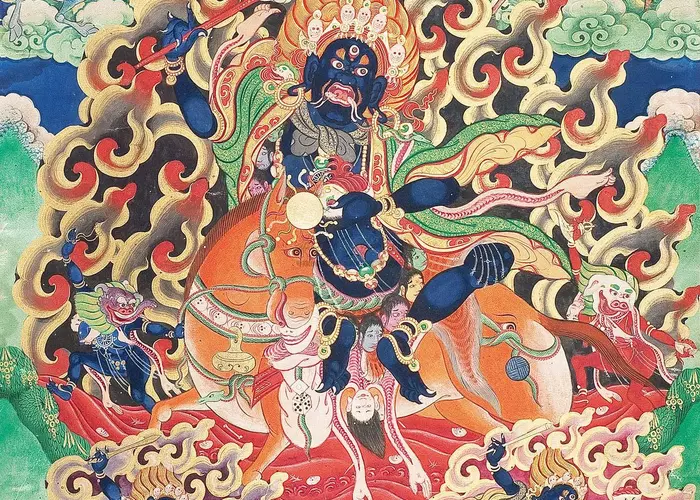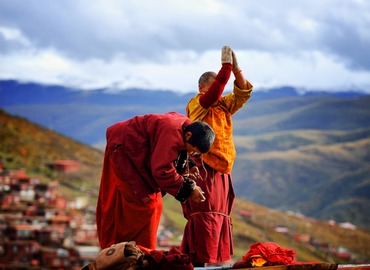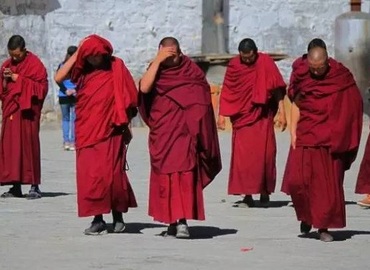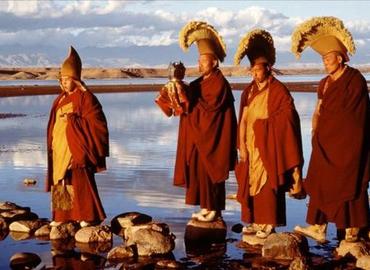12 Tibetan Deities
- Catherine
- Last Updated : 07/29/2025
Tibetan Buddhism began in the Songtsen Gampo era in the 7th century. With the arrival of Princess Bhrikuti of Nepal and Princess Wencheng of the Tang Dynasty, Buddhist gods, an important symbol of Buddhism, were introduced to Tibet. From a certain perspective, the 8-year-old Shakyamuni Buddha statue brought by Princess Bhrikuti and the 12-year-old Shakyamuni statue brought by Princess Wencheng almost became the beginning of the history of Tibetan Buddhism. After more than 1,300 years of historical evolution and development, an intense ethnic style and local characteristics have been formed.
To this day, Buddhist deities still provide an important method and content for Buddhist monks' studying and practicing in Tibetan monasteries. The Tibetan deities in the list can be found in almost all Tibetan monasteries and temples, as well as their significance, identifications, and images.
Buddhas
Buddha figures are the most enshrined category in Tibetan areas, including Shakyamuni Buddha, Jampa Buddha, Immortal Buddha, Medicine Buddha, etc. Some statues are renowned like the 12-year-old Shakyamuni statue enshrined in the Jokhang Temple, the 8-year-old Shakyamuni statue enshrined in the Ramoche Temple, the Qamba Buddha statue in the Tashilhunpo Monastery, the Qamba Buddha statue in the Drepung Monastery, and the Shakyamuni statue in the Sakya Monastery.
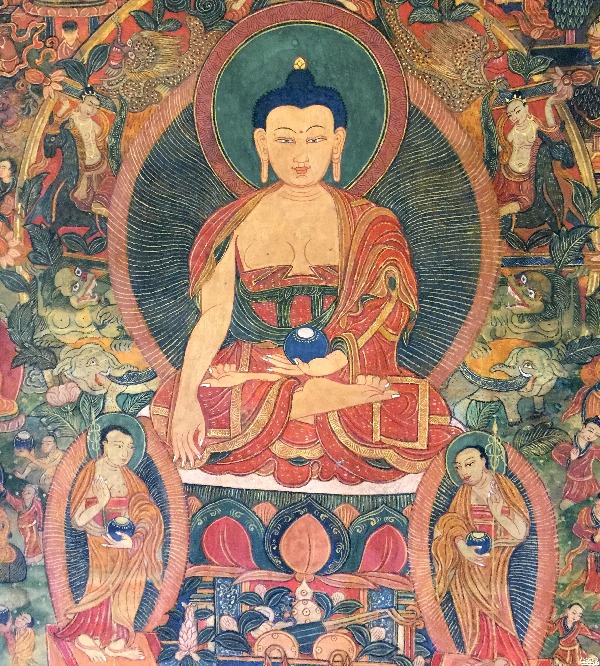
1. Shakyamuni
Who is it?
Shakyamuni, formerly known as Gautama Siddhartha, is the founder of Buddhism. Shakyamuni was born in Kapilavastu, the north of ancient India around 500BC, and he was the son of King Śuddhodana. After enlightenment, he was respected by the world as "Sakyamuni", meaning "the sage of the Sakyamuni".
How can I tell?
Buddha Shakyamuni sits on the vajra seat with his left hand on his feet or holding a bowl, which means meditation. His right hand points vertically to the ground, which means that Buddha Sakyamuni sacrificed everything to attain liberation for all living beings.
Bodhisattvas
Bodhisattva figures also account for a large proportion of Tibetan Buddhism. In Tibetan Buddhism, Guanyin is the most respected person in the Bodhisattva beliefs, followed by Manjusri, Samantabhadra, Ksitigarbha Bodhisattva, etc. Avalokitesvara with a thousand hands and a thousand eyes is a common kind of Guanyin.
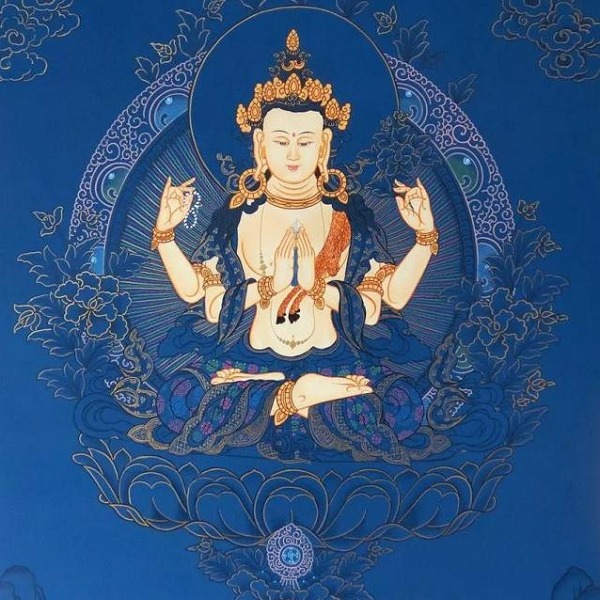
2. Guanyin
Who is it?
Guanyin is the incarnation of wisdom and compassion in Buddhism. When all beings encounter any difficulties and pains and can recite the name of Guanyin sincerely, they will be rescued by Guanyin. The famous Potala Palace in Lhasa is considered to be the dojo of Guanyin Bodhisattva. Potala is the transliteration of Sanskrit, translated as "Po Lo", referring to the island where Guanyin lives. The "six-character mantra" (Om Mani Pad Mi Hum), which is well known to all Tibetans, is the mantra of Guanyin Bodhisattva. In Tibet, Songtsen Gampo is regarded as the incarnation of Guanyin Bodhisattva.
How can I tell?
Holding a jade vase and wearing a crown, she rides on a Golden Roar. Because she is dedicated to assisting Amitabha, and saving the world by seeking the sound of suffering, she has a Buddha statue of Amitabha on her crown.
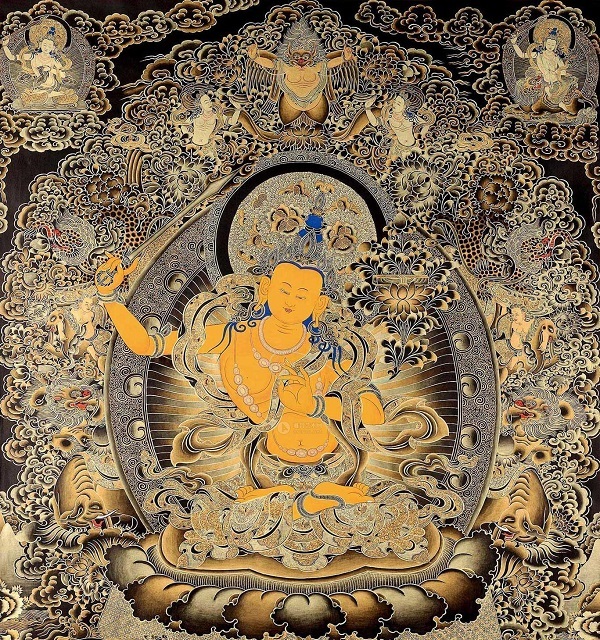
3. Manjusri
Who is it?
Manjusri Bodhisattva is responsible for wisdom in Buddhism, and his dojo is in Mount Wutai, Shanxi, China. In Buddhist temples, he usually stands on the left side of Sakyamuni Buddha, serving as the left guard.
How can I tell?
Manjusri’s images are mostly "non-male and non-female", but they are actually more like a female. Manjusri’s mount is a green lion, representing wisdom and mighty power. She is holding a sword, which represents wisdom. The image of Manjusri of Tantric Buddhism, topped with five buns, indicates that the five kinds of Buddha wisdom are sufficient.
Taras
In Tibetan Buddhism, Tara is called "Dolma". According to legend, she is the incarnation of Guanyin Bodhisattva who manifested herself to save the sufferings. According to the sutra, Tara is transformed from the eyes of Guanyin Bodhisattva. There are 21 forms in total. They have different body colors. Tibetan Buddhism calls them 21 Tara. The most common and popular Tara statues in Tibetan monasteries are White Tara and Green Tara. According to Tibetan Buddhism, White Tara is the incarnation of Nepalese Princess Bhrikuti, while Green Tara is said to be the incarnation of Princess Wencheng. Most Buddhist temples in Tibet enshrine these two statues of Tara.
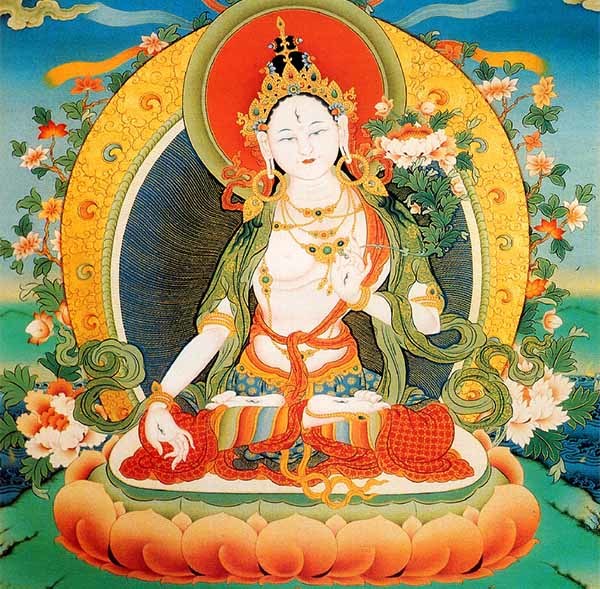
4. White Tara
Who is it?
In Tibetan Buddhism, White Tara is one of the three deities of longevity. If we want to live longer for ourselves or others, praying for White Tara is very important.
How can I tell?
White Tara has a pure white body as well a dignified and peaceful face. She has one eye on her hands and feet, and three eyes on her face, so she is also called the seven-eyed goddess.
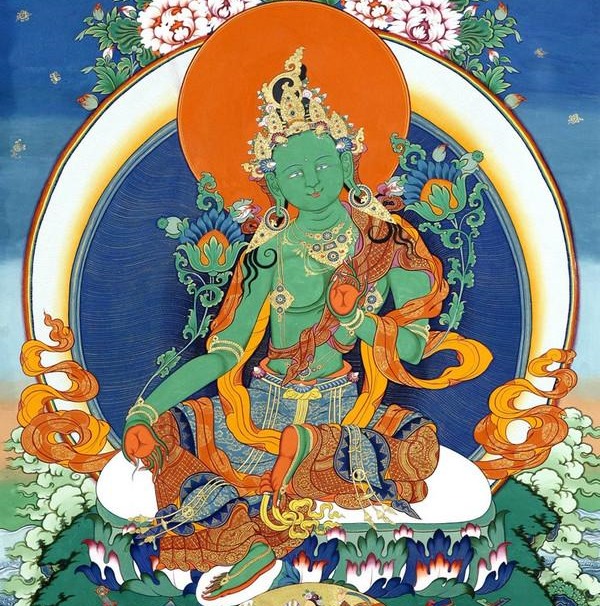
5. Green Tara
Who is it?
She can save eight kinds of suffering. At the same time, she can turn "suspicion", one of the Five Poisons in human behavior into complete wisdom, which has the merits of protecting women and children.
How can I tell?
The statue of Green Tara is in Bodhisattva costume. The whole body is emerald green, and her head is wearing a small five Buddha crown. Her left hand is placed on the chest, holding Utpala flower (blue lotus), and the right leg is stretched out.
Goddesses
They are female protector deities worshipped in Tantric Buddhism. According to Tibetan Buddhism, the goddess is the source of all Buddhas. It mainly includes Palden Lhamo, Dakini, Usnisavijaya, Ushnisha Sitatapatra, and so on.
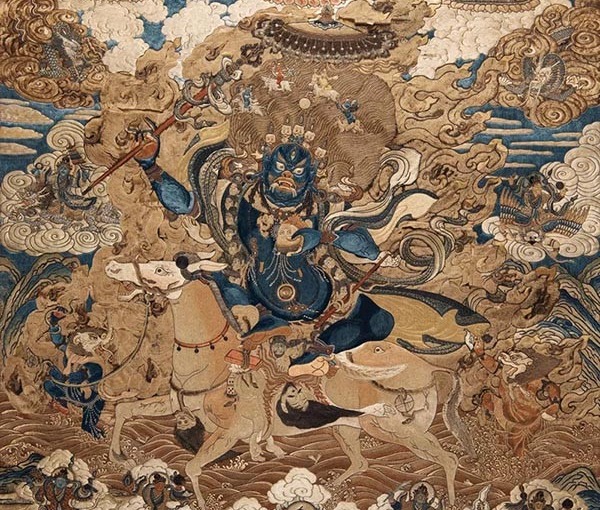
6. Palden Lhamo
Who is it?
Palden Lhamo (Tibetan: དཔལ་ལྡན་ལྷ་མོ།, Sanskrit: Lakshmi) is an important female guardian deity of Tantric Buddhism. In Chinese Buddhism, she is referred to as either “Meritorious god”(功德天) or “Auspicious goddess”(吉祥天女). She's the goddess of happiness and wealth.
How can I tell?
In Tibetan Buddhism, Palden Lhamo has both peaceful and wrathful forms.
The latter form is a fierce deity. She is usually depicted as deep blue in color and with red hair, riding side-saddle on a yellow mule. On her head, there are five human skulls, crescent-shaped adornments, and peacock feathers. Her left hand holds a skeleton stick, which was specially designed to deal with the evil spirit Asura. Her right hand holds a skull bowl full of blood.
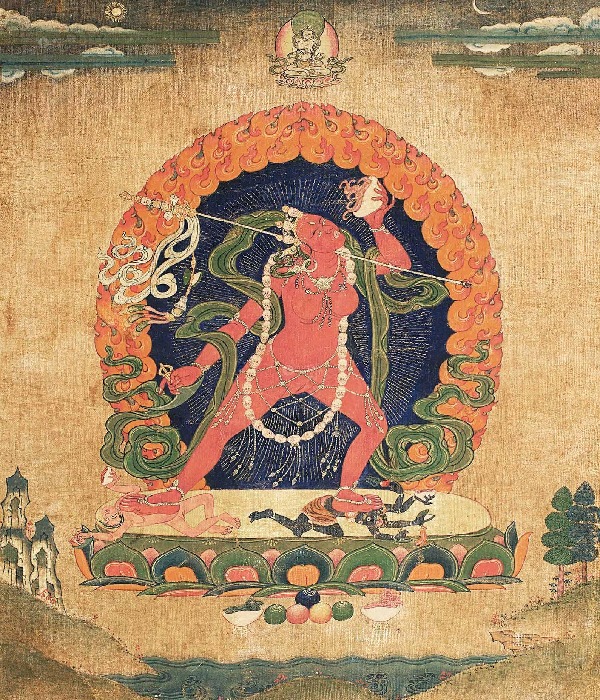
7. Dakini
Who is it?
Dakini, the Sanskrit transliteration, means a person walking in the air. Dakini is a female deity. She is powerful enough to fly in the air, hence her name. In Tantric Buddhism, the Dakini is the goddess of wisdom and compassion.
How can I tell?
She wears a crown of five skulls on her head, with a bare body, thin waist and soft abdomen. Her neck hangs fifty skulls. With the left arm elbow raised, she holds a skull cup (kapala) for a drink in her left hand, and a curved knife in her right hand, standing on the lotus pedestal in a flying posture.
Dharma Protectors
Dharma protectors are the deities who protect the Buddha's Dharma. Buddhism believes that when the Bodhisattva spreads the Dharma if there are no effective protectors, Buddhism will fall. They can benefit all living beings, as well as drive away those who endanger Dharma. They have extraordinary supernatural powers and are invincible. Many figures are the combinations of ancient Indian Brahmanism and Tibetan primitive religion - Bon.
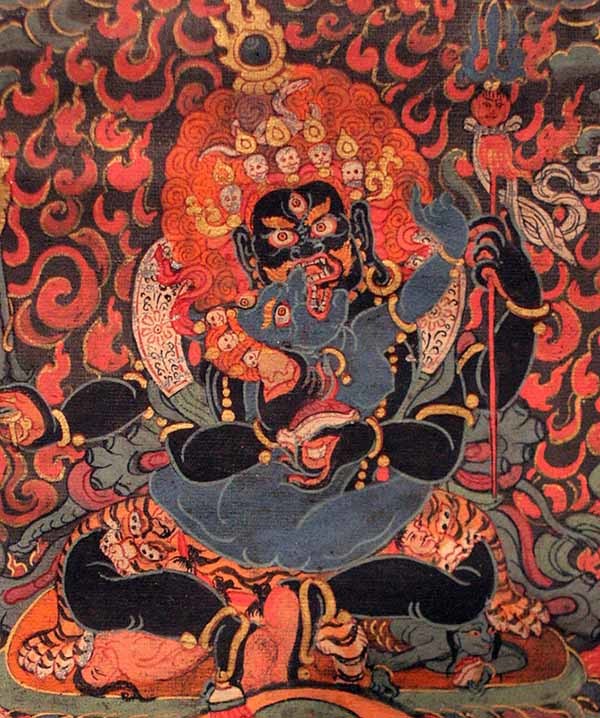
8. Mahākāla
Who is it?
Mahākāla (Sanskrit, Literal: Great Black One) is a protector deity, which means "beyond time" or death. He is the wisdom protector recommended by all sects of Tibetan Buddhism.
How can I tell?
With three eyes, Mahākāla is of the brilliance of 10 million black fires of dissolution and dwells in the midst of eight cremation grounds. He is depicted in a number of manifestations. The most notable variation in Mahakala's manifestations and depictions is in the number of arms.
The Two-Armed Mahakala is the wrathful incarnation of the Ādi-Buddha, as well as of the Buddha Vajradhara. The Four-Armed Mahakala is the incarnation of Cakrasaṃvara. The Six-Armed Black Mahakala is the wrathful incarnation of the eleven-face Avalokitesvara with a thousand hands and a thousand eyes.
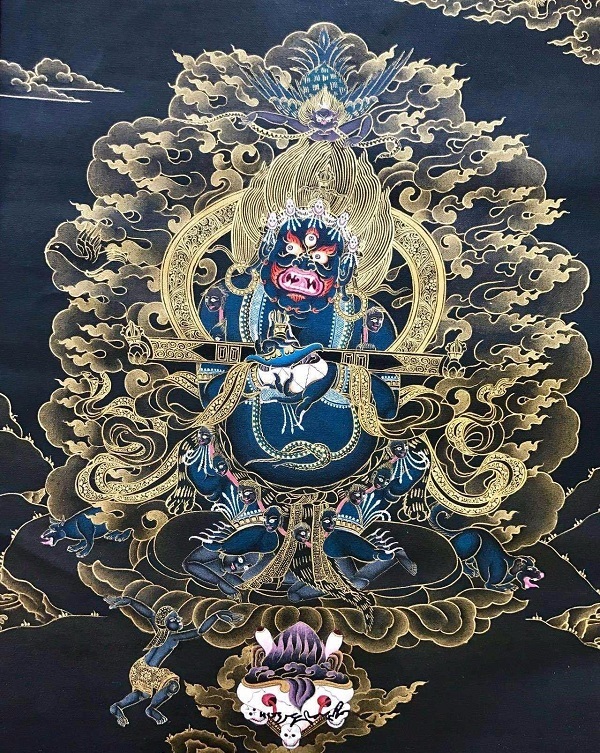
9. Ekajati
Who is it?
Ekajati is the principal guardian deity of the Sakya Sect. In Tibetan Buddhism, the devotional worship of Ekajati can increase the practitioner’s wisdom, prolong one’s life and prevent one from diseases.
How can I tell?
Various forms of her image can be seen in Tibetan Buddhism. Some appear in the form of Tibetan thangka painting. Some appear in the form of copper gilt statues, in gold.
No matter which manifestations and depictions, she is always depicted in dark blue skin with her hair upright like a flame. She steps upon corpses. She is adorned with a crown of five skulls, a skull necklace, bone ornaments, and gems, holding an ax in her right hand and a skull cup in her left.
Vajra Holders
Vajra holders are mainly the deity or protector of Tantric practice in Tibetan Buddhism. The most famous and common ones in Tantric Buddhism are Cakrasamvara, Yamantaka, Hayagriva, Guhyasamāja vajra, Guhyasamāja and so on. Its characteristics generally appear in the image of anger and majesty and have the power to deter evil.
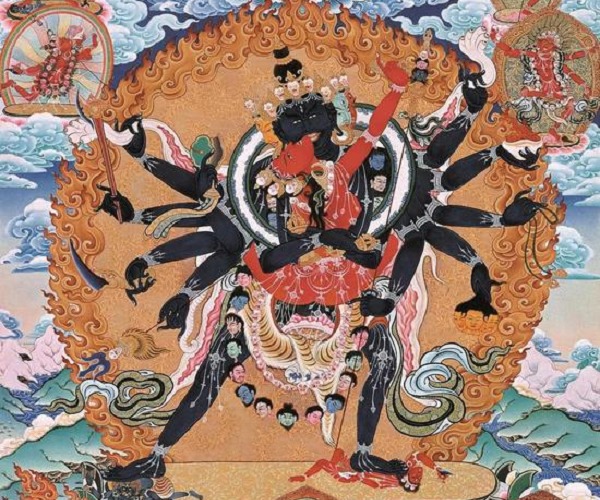
10. Cakrasamvara
Who is it?
"Cakrasaṃvara" may also refer to the main deity in this tantra as well as to a collection of texts or "cycle" associated with the root Cakrasaṃvara tantra. He is one of the five deities honored in the Supreme Yoga Practice of Tibetan Buddhism.
How can I tell?
He is depicted with a blue-colored body, in a standing posture, with four faces(white, yellow, red, and blue), three eyes, and twelve arms, embracing his consort, the wisdom Dakini Vajravārāhī. He holds a vajra in his right hand and a bell in his left hand.
Masters
Master mainly refers to the founders of various sects in the history of Tibetan Buddhism or the figures of famous monks of that sect. Among them, the most commonly known are the Guru Padmasambhava, founder of the Nyingma School, Atisha and Mirarepa of the Kadam School, Guru Tsongkhapa, founder of the Gelug School, and Dalai Lamas and Panchen Lamas.
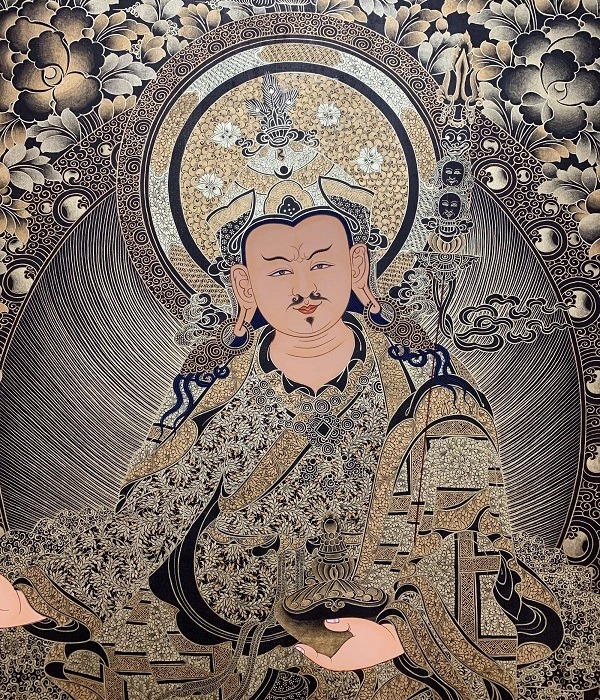
11. Guru Padmasambhava
Who is it?
Padmasambhāva is an ancient Indian, one of the greatest achievers in the history of Indian Buddhism.
From A.D. 763 to A.D. 804, Guru Padmasambhava entered Tibet at the request of King Trisong Dezan to preach the Dharma and established the Nyingma School, the oldest Buddhist sect in Tibet. He also presided over the construction of the Samye Monastery, ordained monks, taught Tantric practice, and translated Buddhist scriptures, so that Buddhism was truly established in Tibet.
How can I tell?
With an angry face, Padmasambhava wears the crown of Dharma on his head. He holds the skull cup in his left hand, with a longevity vase in the cup. He holds the vajra in his right hand and sits on the lotus pedestal.
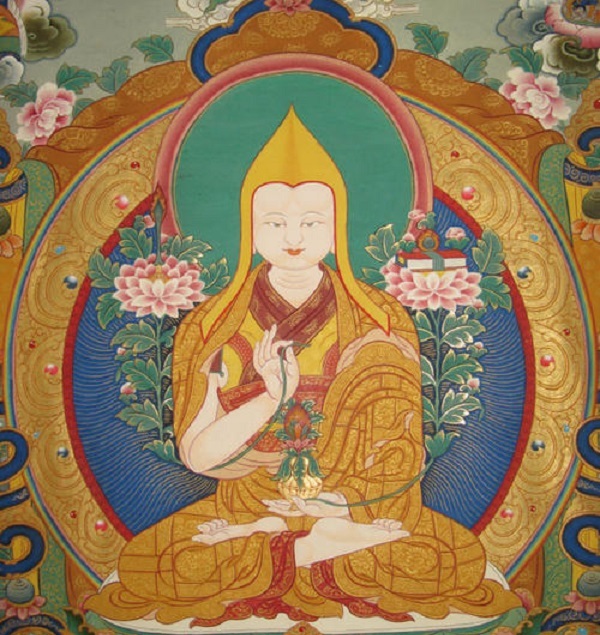
12. Guru Tsongkhapa
Who is it?
Tsongkhapa (1357~1419) is the founder of the Gelug Sect of Tibetan Buddhism and a Buddhist theorist. He has written a lot in his life. His writings discussed the practice order of Exoteric Buddhism and Tantric Buddhism, which has a profound influence on later generations.
How can I tell?
Most of the Tsongkhapa statues wear a yellow, peach-shaped Pandit hat. The hands of Tsongkhapa are in Dharmachakra Pravartana mudrā, which means twisting the thumb and index finger(or middle finger, ring finger) and relaxing the rest of the fingers naturally. Each hand holds a lotus flower, blossoming on the shoulders. The scripture stands in the middle of the left shoulder flower, and the sword stands in the right shoulder flower. This is the same as Manjushri's image. Because Tibetan tantric Buddhism respected Master Tsongkhapa as the incarnation of Manjushri, the scriptures and swords have also become signs of his identity.
Email response within 0.5~24 hours.


